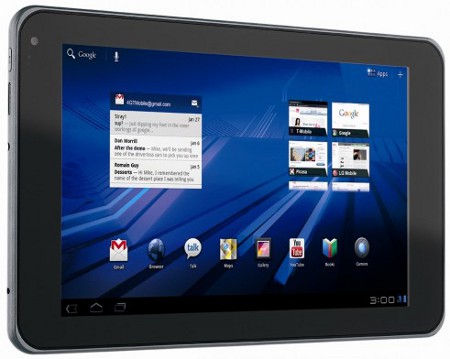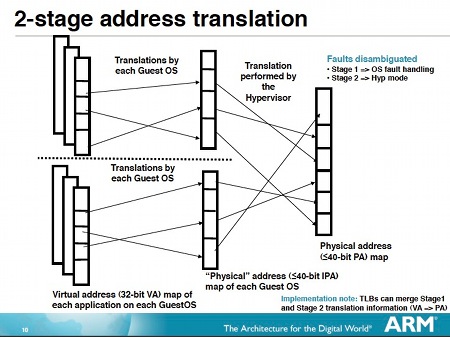LG plays catch-up via ARM Cortex license
Apr 26, 2011 — by LinuxDevices Staff — from the LinuxDevices Archive — 1 viewsLG Electronics announced it has taken out a license with ARM Holdings that will give it access to the Cortex-A15 MPCore and Cortex-A9 MPCore processors. Also covering ARM's Mali-T604 GPU (graphics processing unit) and CoreLink interconnect and system IP, the agreement will “drive … applications that include digital TV, set top boxes (STB), mobile phones, tablets, and smart grids,” the company says.
In a release, LG said it first licensed ARM technology in 1995 and has incorporated ARM processors across its product lines, from handsets to digital TVs. However, recent prominent products from the Korean giant have employed ARM CPUs manufactured by third parties.
 For example, the Optimus 2X (right) — claimed on its December 2010 launch to be the world's first dual-core smartphone — and Optimus Pad tablet both employ Nvidia Tegra 2 processors, as does the LG-manufactured G-Slate (below) promised by T-Mobile. Meanwhile, the similarly Android-based Optimus 3D phone uses a Texas Instruments OMAP4 processor, likely the OMAP4430.
For example, the Optimus 2X (right) — claimed on its December 2010 launch to be the world's first dual-core smartphone — and Optimus Pad tablet both employ Nvidia Tegra 2 processors, as does the LG-manufactured G-Slate (below) promised by T-Mobile. Meanwhile, the similarly Android-based Optimus 3D phone uses a Texas Instruments OMAP4 processor, likely the OMAP4430.

LG's G-Slate, headed for T-Mobile
With the latter CPU, TI was an early adopter of ARM's Cortex-A9 processor core, which implements the same ARMv7 used on the Cortex-A8, and adds an MPCore interconnect layer for multiple processor support. While as many as four cores are possible with MPCore (see block diagram, here), TI's OMAP4430 and OMAP4440 were announced in February 2009 with two cores apiece.
TI began sampling the OMAP4430 in 2010, while other ARM licensees began to catch up, launching Cortex-A9 SoC (systems on chip) of their own. Examples include:
- Nvidia's Tegra 250
- Renesas' EMMA Mobile/EV1 and Mobile EV/2
- Nufront's NuSmart 2816
- STMicroelectronics' SPEAr1310
LG's archrival Samsung came relatively late to the Cortex-A9 party, announcing an SOC code-named "Orion" just last September. Now branded as the Exynos 4210, the SoC — too new to have made it into any devices — includes an HD-ready video encoder/decoder, a "high-speed" 3D GPU, support for LPDDR2 or DDR3 memory, and an integrated GPS receiver, Samsung says.
Previous Cortex-A15 adopters
Eager-beaver TI touted itself as "the first licensee of the next-generation ARM Cortex-A series processor core" even before the Cortex-A15 was formally announced. And certainly, there's a lot to like here.
For example, the Cortex-A15 MPCore is equipped with an out-of-order superscalar pipeline, along with a tightly-coupled low-latency level-2 cache of up to 4MB, according to ARM. The processor can decode and dispatch up to three instructions per cycle, says the company. This is said to be three times the rate possible with an ARM11 processor.
In addition, the Cortex-A15 can issue up to eight instructions per cycle, and take less than 10 microseconds to move into standby or wake up again. Floating point and NEON instruction set performance for signal processing and multimedia have also been improved, says ARM.
Compared to the Cortex-A9, the Cortex-A15 adds more efficient hardware support for operating system (OS) virtualization, soft-error recovery, larger memory addressability, and system coherency, says ARM. Large Physical Address Extensions (LPAE), shown in the diagram below, are said to permit addressing up to 1TB of memory.

LPAE will let ARM Cortex-A15 CPUs work with physical memory up to 1TB
(Click to enlarge)
In February, TI announced the OMAP5430 and OMAP5432 and said they would begin sampling during the second half of 2011. They'll offer dual Cortex-A15 cores clocked at 2GHz, support for up to four cameras, HD video encode/decode in 2D or 3D, imaging up to 24 megapixels, and Kinect-like gesture support, the company said.
Meanwhile, Nvidia announced in January that it had licensed the Cortex-A15 core for future-generation Tegra processors. The company also said it has obtained an ARM architectural license, which it will use to develop a CPU that "fully integrates" a GPU. (Separately, the company's "Kal-El" processor, featuring four Cortex-A9 cores, will reportedly be released as the Tegra 3 later this year.)
Another home for Cortex-A15 IP has been announced by ST-Ericsson, which said in Febuary that its Nova A9600 will begin sampling sometime this year. The 28nm-fabbed A9600 will offer dual cores clocked at up to 2.5GHz, plus Imagination Technologies' Series6 ("Rogue") graphics IP, giving it the ability to play full HD video at up to 120 frames per second, the company says.
Playing catch-up?
Given the rival developments chronicled above, it's hard not to conclude that — unless it has been working behind the scenes for months — LG will be well behind its competitors when it comes to shipping ARM Cortex-A9 or Cortex-A15 SoCs. Still, with cited 2009 global sales of more than $43.4 billion, the company ought to be able to consume all the processors it can produce.
LG will not be able to employ its own SoCs in its Windows Phone 7 handsets (such as the already released LG Quantum, however. That's because Microsoft's chassis specs for such devices continue to mandate the use of selected Qualcomm chipsets.
Jonathan Angel can be followed at www.twitter.com/gadgetsense.
This article was originally published on LinuxDevices.com and has been donated to the open source community by QuinStreet Inc. Please visit LinuxToday.com for up-to-date news and articles about Linux and open source.